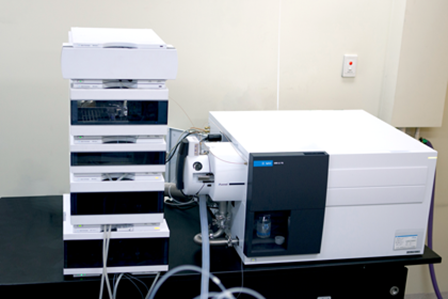 The Baker Institute’s Metabolomic Profiling Facility allows us to systematically study the unique metabolite (small-molecule) fingerprints of biological systems.
The Baker Institute’s Metabolomic Profiling Facility allows us to systematically study the unique metabolite (small-molecule) fingerprints of biological systems.
Analytical platform
The facility comprises of 4x triple quadrupole mass spectrometers (Agilent 6495C) each coupled to a 1290 Infinity II LC System. These systems are set up for high-throughput analysis of lipids in human plasma and serum, as well as more in-depth analysis of lipids in isolated from tissues, cells and other biological materials. The facility also houses a quadrupole time of flight instrument (Agilent 6546 Q-TOF) coupled to a 1290 Infinity II LC System used for high resolution untargeted analysis of both lipids and metabolites across all biological samples.
Our approach and capabilities
We have developed a high throughput lipidomics approach that enables the analysis of approximately 800 lipid species from over 35 lipid classes and subclasses (see Table 1). The analysis is performed by liquid chromatography tandem mass spectrometry on one of the instruments within the Metabolomics laboratory. We use stable isotope internal standards (approximately one per class) to provide semi-quantitative data on each of the over 800 lipid species.
This analysis typically required only small amounts of biological material (10 μL plasma or 50 μg cellular protein from cell or tissue homogenates).
Study design
We can advise on appropriate experimental design to minimise variance across the experiment and maximise statistical power. Experiments can comprise anywhere from 20 to over 5000 samples. The appropriate use of quality control samples provides for standardisation across and between analytical runs.
Lipid extraction
We have developed SOPs for lipid extraction from biological fluids, cells and tissues that provide high recoveries and reproducibility.
Liquid chromatography mass spectrometry
Our experienced researchers maintain and run the mass spectrometers for the analysis of in-house and external samples.
Data extraction and analysis
Data processing is performed on specialised software available within the Metabolomics laboratory. Analysis of lipidomic data presents some specific challenges. We can also advise on, and support, subsequent statistical analysis with our established lipidomic workflow utilising open source R software to allow for ease of transparency in publication. These analyses can extend to multivariate modelling utilising machine learning approaches within a cross validation framework to create and evaluate classification or prediction models.
| Metabolite class | Abbreviation | Number of species |
| Acylcarnitine | AC | 27 |
| Alkenyllysophosphatidylcholine | LPC(P) | 6 |
| Alkenyllysophosphatidylethanolaime | LPE(P) | 4 |
| Alkenylphosphatidylcholine | PC(P) | 26 |
| Alkenylphosphatidylcholine | PE(P) | 54 |
| Alkyldiacylglycerol | TG(O) | 20 |
| Alkyllysophosphatidylcholine | LPC(O) | 10 |
| Alkylphosphatidylcholine | PC(O) | 22 |
| Alkylphosphatidylcholine | PE(O) | 14 |
| Bile Acids | BA | 2 |
| Ceramide | Cer(d) | 50 |
| Ceramide-1-Phosphate | C1P | 1 |
| Cholesteryl Esters | CE | 27 |
| Dehydrocholesteryl ester | DE | 6 |
| Dehydrodesmosteryl ester | deDE | 3 |
| deoxyCeramdie | Cer(m) | 11 |
| Diacylglycerol | DG | 25 |
| Dihexosylceramide | Hex2Cer | 10 |
| Dihydroceramide | dhCer | 6 |
| Dimethyl-cholesteryl esters | dimethyl-CE | 4 |
| Free Cholesterol | COH | 1 |
| Free fatty acids | FFA | 18 |
| GM1 Gangliosides | GM1 | 1 |
| GM3 Gangliosides | GM3 | 6 |
| Hexosylceramide | HexCer | 14 |
| Hydroxy-Acylcarnitine | AC-OH | 10 |
| Lysophosphatidylcholine | LPC | 61 |
| Lysophosphatidylethanolamine | LPE | 14 |
| Lysophosphatidylinositol | LPI | 8 |
| Methyl-cholesteryl ester | methyl-CE | 5 |
| Methyl-dehydrocholesteryl ester | methyl-DE | 2 |
| Oxidised Lipids | OxSpecies | 9 |
| Phosphatidic acid | PA | 6 |
| Phosphatidylcholine | PC | 69 |
| Phosphatidylethanolamine | PE | 37 |
| Phosphatidylglycerol | PG | 3 |
| Phosphatidylinositol | PI | 27 |
| Phosphatidylinositol phosphate | PIP1 | 1 |
| Phosphatidylserine | PS | 7 |
| Sphingomyelin | SM | 44 |
| Sphingosine | Sph | 3 |
| Sphingosine-1-phosphate | S1P | 4 |
| Sulfatide | SHexCer | 6 |
| Triacylglycerol | TG | 79 |
| Trihexosylceramide | Hex3Cer | 6 |
| Ubiquinone | Ubiquinone | 1 |
| Total | 770 | |
Training and collaborations
We work with both internal and external groups on collaborative projects. Training can be provided to collaborating laboratories to facilitate the processing and analysis of biological samples. Development of additional capabilities is ongoing and we are happy to discuss project specific needs.
Current projects within the Metabolomics laboratory
- Identifying novel lipid and genetic signatures of metabolic disease in early childhood.
- A systems epidemiology approach to define metabolic and genomic determinants of alzheimer’s disease.
- Genome wide association studies for the identification, validation and therapeutic targeting of lipid metabolic pathways in cardiometabolic disease.
- Metabolomic studies into the pathogenesis and risk assessment of type 2 diabetes.
- Plasmalogen modulation: A new therapeutic strategy for the prevention and management of non-alcoholic fatty liver disease.
- Pathogenesis and risk assessment of coronary artery disease.
- Lipidomic analysis of the FIELD Trial: mechanism of action and prediction of response to fenofibrate treatment in type 2 diabetes.
- Dyslipidaemia resulting from obesity is a major contributor to the onset and progression of type 2 diabetes.


